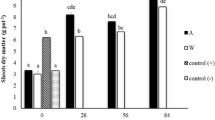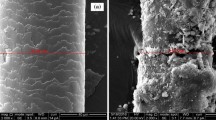Abstract
The growing animal protein production results in a high generation of waste considered environmental pollutants, such as swine hair, which is composed of keratin. This protein has characteristics such as rigidity, making it a natural polymer. Given this, alternatives for this waste to be disposed of without harming the environment are desirable, such as biological pre-treatment that makes the waste less rigid, facilitating access to nutrients present in its structure when disposed of in the soil and also enabling the production of keratinase, one an enzyme with high specificity for residues composed of keratin. In this context, this study aimed to evaluate the final disposition of swine hair pre-treated with Trichoderma sp. in the soil and its effect on the development of tomato seedlings and to evaluate the production of keratinase from the pre-treatment process. As a result, the final disposal of these pre-treated residues was effective since there were no significant changes in soil characteristics but increased nutrients such as nitrogen, potassium, and calcium in tomato seedlings. Also, keratinolytic activity values of 326.61 ± 42.33 and 403.3 ± 71.65 U/g were obtained within 24 h of the process. Finally, it can be concluded that in addition to not negatively affecting the environment and the development of tomato seedlings, after biologically pre-treated, swine hair can act as an adsorbent of heavy metals, reducing their concentrations in the soil. So, the significance of this study could be synthesized in biological pre-treatment enabled the use of swine hair for multivariate purposes; the fermentation process resulted in elevated keratinolytic activity; the treated swine hair decreased concentrations of heavy metals in the soil; and swine hair pre-treated biologically provide the increment of nutrients in the soil.
Graphical Abstract



Similar content being viewed by others
Data Availability
The datasets generated for this study are available to the corresponding author on request.
References
Altomare, C., Norvell, W. A., Björkman, T., et al. (1999). solubilization of phosphates and micronutrients by the plant-growth-promoting and biocontrol fungus Trichoderma harzianum Rifai 1295-22. Applied and Environmental Microbiology, 65, 2926–2933. https://doi.org/10.1128/AEM.65.7.2926-2933.1999
Bagewadi, Z. K., Mulla, S. I., & Ninnekar, H. Z. (2018). Response surface methodology based optimization of keratinase production from Trichoderma harzianum isolate HZN12 using chicken feather waste and its application in dehairing of hide. Journal of Environmental Chemical Engineering, 6, 4828–4839. https://doi.org/10.1016/j.jece.2018.07.007
Beryl, G. P., Thazeem, B., Umesh, M., et al. (2021). Bioconversion of feather composts using proteolytic bacillus mycoides for their possible application as biofertilizer in agriculture. Waste and Biomass Valorization, 12, 6795–6809. https://doi.org/10.1007/s12649-021-01472-4
Bhari, R., Kaur, M., & Sarup Singh, R. (2021). Chicken feather waste hydrolysate as a superior biofertilizer in agroindustry. Current Microbiology, 78, 2212–2230. https://doi.org/10.1007/s00284-021-02491-z
Biswas, I., Mitra, D., Senapati, A., et al. (2021). Valorization of vermicompost with bacterial fermented chicken feather hydrolysate for the yield improvement of tomato plant: A novel organic combination. International Journal of Recycling Organic Waste in Agriculture, 1, 29–42 https://doi.org/4.1904599.2020.IJROWA/30486.10
Brandelli, A. (2008). Bacterial keratinases: Useful enzymes for bioprocessing agroindustrial wastes and beyond. Food and Bioprocess Technology, 1, 105–116. https://doi.org/10.1007/s11947-007-0025-y
Bressollier, P., Letourneau, F., Urdaci, M., et al. (1999). Purification and characterization of a keratinolytic serine proteinase from Streptomyces albidoflavus. Applied and Environmental Microbiology, 65, 2570–2576. https://doi.org/10.1128/AEM.65.6.2570-2576.1999
Chen, Y., Li, W., & Zhang, S. (2021). A multifunctional eco-friendly fertilizer used keratin-based superabsorbent as coatings for slow-release urea and remediation of contaminated soil. Progress in Organic Coatings, 154, 106158. https://doi.org/10.1016/j.porgcoat.2021.106158
De Paris, O. J., Scapini, T., Camargo, A. F., et al. (2019). Removal of chromium from wastewater by swine hair residues applied as a putative biofilter. Environmental Science and Pollution Research, 26, 33014–33022. https://doi.org/10.1007/s11356-019-06313-5
Dipankar, P., & Bhan, C. (2019). Role of keratinase in bioremediation of feathers and hairs. In Smart Bioremediation Technologies (pp. 83–98). Elsevier.
Du Jardin, P. (2015). Plant biostimulants: Definition, concept, main categories and regulation. Scientia Horticulturae (Amsterdam)., 196, 3–14. https://doi.org/10.1016/j.scienta.2015.09.021
FAO (2022) OECD-FAO: América Latina e Caribe tem grande potencial para expandir produção de alimentos, Accessed 27 November 2022 https://www.fao.org/brasil/noticias/detail-events/pt/c/1585152/.
Gupta, R., & Ramnani, P. (2006). Microbial keratinases and their prospective applications: an overview. Applied Microbiology and Biotechnology, 70, 21–33. https://doi.org/10.1007/s00253-005-0239-8
Harman, G. E., Howell, C. R., Viterbo, A., et al. (2004). Trichoderma species — Opportunistic, avirulent plant symbionts. Nature Reviews. Microbiology, 2, 43–56. https://doi.org/10.1038/nrmicro797
Karthika, K. S., Rashmi, I., & Parvathi, M. S. (2018). Biological functions, uptake and transport of essential nutrients in relation to plant growth. In Plant Nutrients and Abiotic Stress Tolerance (pp. 1–49). Springer Singapore.
Kothari, D., Rani, A., & Goyal, A. (2017). Keratinases. In Current Developments in Biotechnology and Bioengineering (pp. 447–469). Elsevier.
Liang, X., Li, F., Zhong, S., et al. (2022). Resource utilization of swine hair to prepare low-cost adsorbents with high density of sulfhydryl for enhanced and trace level removal of aqueous Hg(II). International Journal of Biological Macromolecules, 220, 79–89. https://doi.org/10.1016/j.ijbiomac.2022.08.062
MMA, M.D.M.A.-C.N.D.M.A (2009) RESOLUÇÃO No 420, DE 28 DE DEZEMBRO DE 2009. , Brazil (in Portuguese).
Modkovski, T. A., Scapini, T., Dalastra, C., et al. (2020). (2020) hexavalent chromium removal using filamentous fungi: Sustainable biotechnology. Industrial Biotechnology, 16, 125–132. https://doi.org/10.1089/ind.2019.0034
Olawale, S. A., Bonilla-Petriciolet, A., & Mendoza-Castillo, D. I. (2022). thermodynamics and mechanism of the adsorption of heavy metal ions on keratin biomasses for wastewater detoxification. Adsorption Science and Technology, 2022, 1–13. https://doi.org/10.1155/2022/7384924
Onifade, A. A., Al-Sane, N. A., Al-Musallam, A. A., et al. (1998). A review: Potentials for biotechnological applications of keratin-degrading microorganisms and their enzymes for nutritional improvement of feathers and other keratins as livestock feed resources. Bioresource Technology, 66, 1–11. https://doi.org/10.1016/S0960-8524(98)00033-9
Pandey, R. (2015). Mineral nutrition of plants. In Plant Biology and Biotechnology (pp. 499–538). Springer India.
Papadopoulos, M. C., El Boushy, A. R., Roodbeen, A. E., et al. (1986). Effects of processing time and moisture content on amino acid composition and nitrogen characteristics of feather meal. Animal Feed Science and Technology, 14, 279–290. https://doi.org/10.1016/0377-8401(86)90100-8
Paul, T., Halder, S. K., & Das, A. (2013). Exploitation of chicken feather waste as a plant growth promoting agent using keratinase producing novel isolate Paenibacillus woosongensis TKB2. Biocatalysis and Agricultural Biotechnology, 2, 50–57. https://doi.org/10.1016/j.bcab.2012.10.001
Popko, M., Michalak, I., Wilk, R., et al. (2018). (2018) Effect of the new plant growth biostimulants based on amino acids on yield and grain quality of winter wheat. Molecules, 23, 470. https://doi.org/10.3390/molecules23020470
Preczeski, K. P., Dalastra, C., Czapela, F. F., et al. (2020). Fusarium oxysporum and Aspergillus sp. as keratinase producers using swine hair from agroindustrial residues. Frontiers in Bioengineering and Biotechnology, 8, 1–8. https://doi.org/10.3389/fbioe.2020.00071
Rahman, R., & Upadhyaya, H. (2021). Aluminium toxicity and its tolerance in plant: A review. Journal of Plant Biology, 64, 101–121. https://doi.org/10.1007/s12374-020-09280-4
Rai, S. K., Konwarh, R., & Mukherjee, A. K. (2009). Purification, characterization and biotechnological application of an alkaline β-keratinase produced by Bacillus subtilis RM-01 in solid-state fermentation using chicken-feather as substrate. Biochemical Engineering Journal, 45, 218–225. https://doi.org/10.1016/j.bej.2009.04.001
Saha, S., Zubair, M., Khosa, M. A., et al. (2019). Keratin and chitosan biosorbents for wastewater treatment: A review. Journal of Polymers and the Environment, 27, 1389–1403. https://doi.org/10.1007/s10924-019-01439-6
Schuster, A., & Schmoll, M. (2010). Biology and biotechnology of Trichoderma. Applied Microbiology and Biotechnology, 87, 787–799. https://doi.org/10.1007/s00253-010-2632-1
Shetty, R., Vidya, C. S. N., Prakash, N. B., et al. (2021). Aluminum toxicity in plants and its possible mitigation in acid soils by biochar: A review. Science of the Total Environment, 765, 142744. https://doi.org/10.1016/j.scitotenv.2020.142744
Singh, B. N., Dwivedi, P., Sarma, B. K., et al. (2019). A novel function of N-signaling in plants with special reference to Trichoderma interaction influencing plant growth, nitrogen use efficiency, and cross talk with plant hormones. 3 Biotech, 9. https://doi.org/10.1007/s13205-019-1638-3
Singh, S., Tripathi, D. K., Singh, S., et al. (2017). Toxicity of aluminium on various levels of plant cells and organism: A review. Environmental and Experimental Botany, 137, 177–193. https://doi.org/10.1016/j.envexpbot.2017.01.005
Sophia, A. C., & Sai, S. (2016). Modified microbial fuel cell for Cr(VI) reduction and simultaneous bio-electricity production. Journal of Environmental Chemical Engineering, 4, 2402–2409. https://doi.org/10.1016/j.jece.2016.04.025
Srivastava, B., Khatri, M., Singh, G., et al. (2020). Microbial keratinases: An overview of biochemical characterization and its eco-friendly approach for industrial applications. Journal of Cleaner Production, 252, 119847. https://doi.org/10.1016/j.jclepro.2019.119847
Sun, P., Liu, Z. T., & Liu, Z. W. (2009). Chemically modified chicken feather as sorbent for removing toxic chromium(VI) ions. Industrial and Engineering Chemistry Research, 48, 6882–6889. https://doi.org/10.1021/ie900106h
Sun, Z., Li, X., Liu, K., et al. (2021). Optimization for production of a plant growth promoting agent from the degradation of chicken feather using keratinase producing novel isolate Bacillus pumilus JYL. Waste and Biomass Valorization, 12, 1943–1954. https://doi.org/10.1007/s12649-020-01138-7
Tedesco, M. J., Gianello, C., Bissani, C. A., et al. (1995). Análise de solos, plantas e outros materiais. UFRGS (in Portuguese).
U.S. EPA, U.S.E.P.A. (1992). METHOD 7196A chromium, hexavalent (colorimetric).
U.S. EPA, U.S.E.P.A. (1994). Method 200.7, Revision 4.4: Determination of metals and trace elements in water and wastes by inductively coupled plasma-atomic emission spectrometry. , CINCINNATI, OHIO
U.S. EPA, U.S.E.P.A. (1996). METHOD 3060A Alkaline digestion for hexavalent chromium.
U.S. EPA, U.S.E.P.A. (2007). METHOD 3051A Microwave assisted acid digestion of sediments, sludges, soils, and oils.
Zin, N. A., & Badaluddin, N. A. (2020). Biological functions of Trichoderma spp. for agriculture applications. Annals of Agricultural Science, 65, 168–178. https://doi.org/10.1016/j.aoas.2020.09.003
Acknowledgements
The authors thank the Brazilian Funding Agencies: Brazilian National Council for Scientific and Technological Development (CNPq - 302484/2022-1), Coordination of the Superior Level Staff Improvement (CAPES), the support of the Bioprocess and Biotechnology for Food Research Center (Biofood), which is funded through the Research Support Foundation of Rio Grande do Sul (FAPERGS-22/2551-0000397-4), Federal University of Fronteira Sul (UFFS), and Federal University of Santa Catarina (UFSC) for the financial support.
Funding
Funding is provided by CAPES, CNPq, and FAPERGS.
Author information
Authors and Affiliations
Contributions
SK, NLD, LHS, AJW, LRP, GHK, and JPN: experimental procedures, results in discussion, and data treatment CB, AFC, AM, HT: research coordinators
Corresponding author
Ethics declarations
Novelty statement
Swine hair pre-treated can be used as an adsorbent of heavy metals in the soil without affecting the environment and the development of tomato seedlings.
Ethics Approval and Consent to Participate
Not applicable.
Consent for Publication
All authors agreed with this publication.
Competing Interests
There are no competing interests
Additional information
Publisher’s Note
Springer Nature remains neutral with regard to jurisdictional claims in published maps and institutional affiliations.
Rights and permissions
Springer Nature or its licensor (e.g. a society or other partner) holds exclusive rights to this article under a publishing agreement with the author(s) or other rightsholder(s); author self-archiving of the accepted manuscript version of this article is solely governed by the terms of such publishing agreement and applicable law.
About this article
Cite this article
Kubeneck, S., Bonatto, C., Diering, N.L. et al. Evaluation of the Disposition Of Swine Hair Pre-treated with Trichoderma sp. in the Soil. Water Air Soil Pollut 235, 107 (2024). https://doi.org/10.1007/s11270-024-06923-x
Received:
Accepted:
Published:
DOI: https://doi.org/10.1007/s11270-024-06923-x




